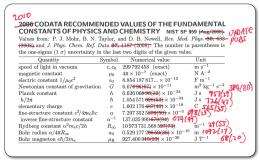The constants they are a changin': NIST posts latest adjustments to fundamental figures

The electromagnetic force has gotten a little stronger, gravity a little weaker, and the size of the smallest "quantum" of energy is now known a little better. The National Institute of Standards and Technology (NIST) has posted the latest internationally recommended values of the fundamental constants of nature.
The constants, which range from relatively famous (the speed of light) to the fairly obscure (Wien frequency displacement law constant) are adjusted every four years in response to the latest scientific measurements and advances. These latest values arrive on the verge of a worldwide vote this fall on a plan to redefine the most basic units in the International System of Units (SI), such as the kilogram and ampere, exclusively in terms of the fundamental constants.
The values are determined by the Committee on Data for Science and Technology (CODATA) Task Group on Fundamental Constants, an international group that includes NIST members. The adjusted values reflect some significant scientific developments over the last four years.
Often the biggest news in a fundamental constant value is a reduced uncertainty—scientists know the value better. The uncertainty in the value of the fine-structure constant alpha (α = 7.297 352 5698 x 10-3), which dictates the strength of the electromagnetic force, has been slashed in half to 0.3 parts per billion (ppb). Since alpha can be measured in a uniquely broad range of phenomena from the recoil of atoms to the magnetic properties of electrons, the consistency of the measurements acts as a barometer of scientists' general understanding of physics. Alpha will also be a critical constant after a redefinition of the SI: it will remain an experimentally determined constant, while quite a few others' values will be fixed to define the basic measurement units.
Also improved is the Planck constant h, which defines the size of the smallest possible "quantum" (packet) of energy, and is central to efforts to redefine the SI unit of mass. The latest value of h (6.626 069 57 x 10-34 joule seconds) takes into account a measurement of the number of atoms in a highly enriched silicon sphere. That value currently disagrees with the other fundamental method for determining h, known as the watt-balance. Even so, when all the values are combined, the overall uncertainty of h (44 ppb) is smaller than in 2006, and the values from the two techniques are getting closer to each other.
The 2010 CODATA values incorporate two new experimental measurements of G, the Newtonian constant of gravitation, which dictates the strength of gravity. The latest value of G (6.673 84 x 10-11 m3 kg-1 s-2) is about 66 parts per million smaller than the 2006 value. Other adjustments have been seen in the constants such as the radius of the proton and other constants related to atoms and gases such as the Rydberg and molar gas constants.
The CODATA task group is preparing a full report on the 2010 adjustments (for now, there is a brief overview), and the report will include recommendations for future measurements. A plan to adopt a fully constant-based SI, being voted upon this October by the General Conference on Weights and Measures, is contingent upon the values of the fundamental constants such as h reaching certain levels of precision and accuracy that will require further measurement advances in the coming years.
More information: physics.nist.gov/constants
Provided by National Institute of Standards and Technology












.jpg)






